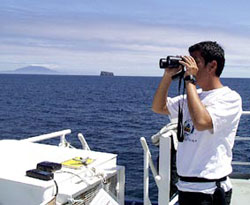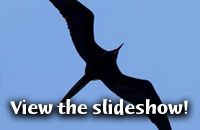|
Hot
Topics: Seabird Observations in the Western Galápagos Islands By Francisco Cruz, Researcher at the Charles Darwin Research Station  Since joining the Revelle at Puerto Ayora, Francisco has spent much of his time doing the seabird study from the fore deck. One of the investigations complementing the geologic studies the scientists on board RV Revelle are carrying out, is a survey of the seabirds inhabiting the Galápagos. The main objective of my seabird study is to determine the number and variety of bird species found in the near shore environment of the western and southern islands: Fernandina, Isabela, Floreana and Española Islands. One of the most spectacular species encountered in this area is the waved albatross. One of the largest birds found in the Galápagos, this bird’s wingspan can exceed 3 meters (over 9 feet). The waved albatross usually nests in the southeastern portion of the archipelago in a place known as Punta Ceballos on Española Island. So far on this cruise, I have frequently observed three endemic subspecies of boobies: the blue-footed, red-footed and masked boobies. The blue-footed booby nests across the entire archipelago, whereas the red-footed booby and masked booby nest only on a few specific islands. The red-footed booby is mainly found on the islands of Genovesa and Marchena north and east of Isabela Island. The masked booby principally inhabits Española Island. |
|
© 2010 Dive and Discover™. Dive and Discover™ is a registered trademark of Woods Hole Oceanographic Institution
|
|

